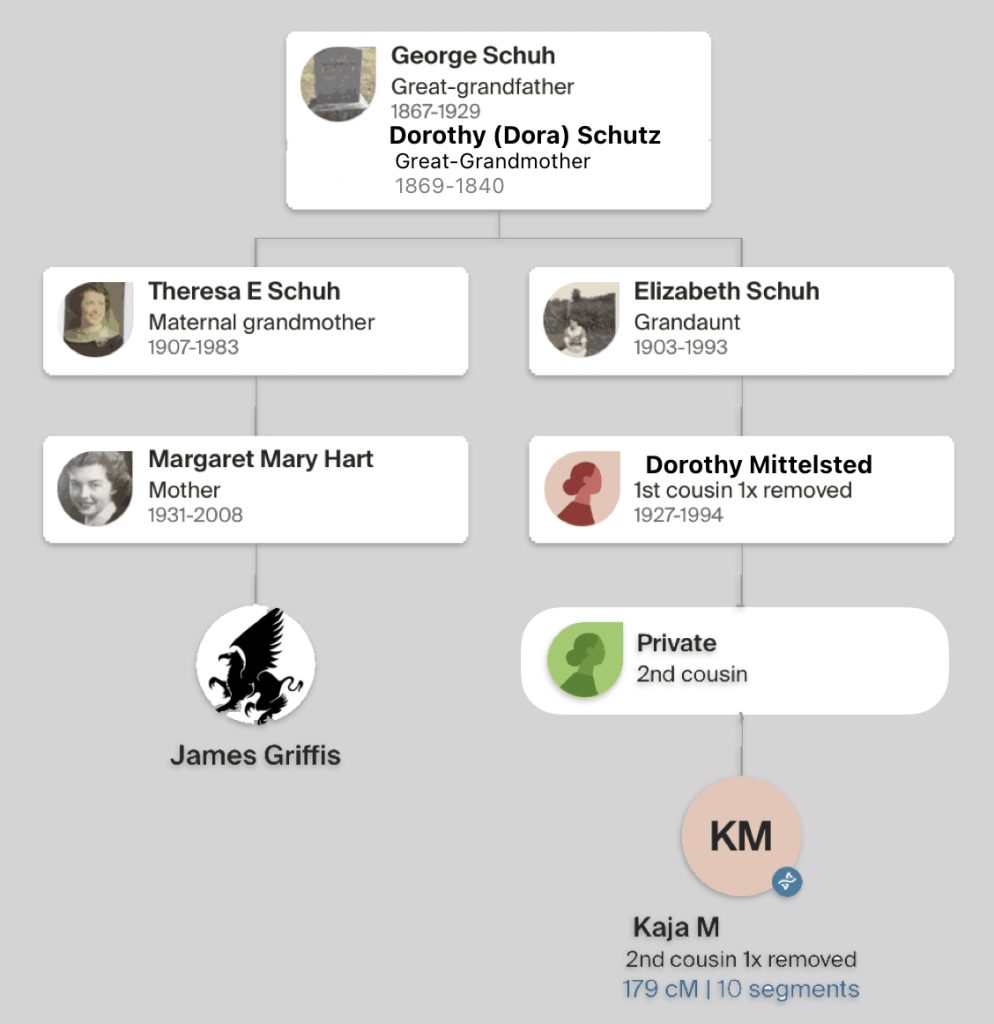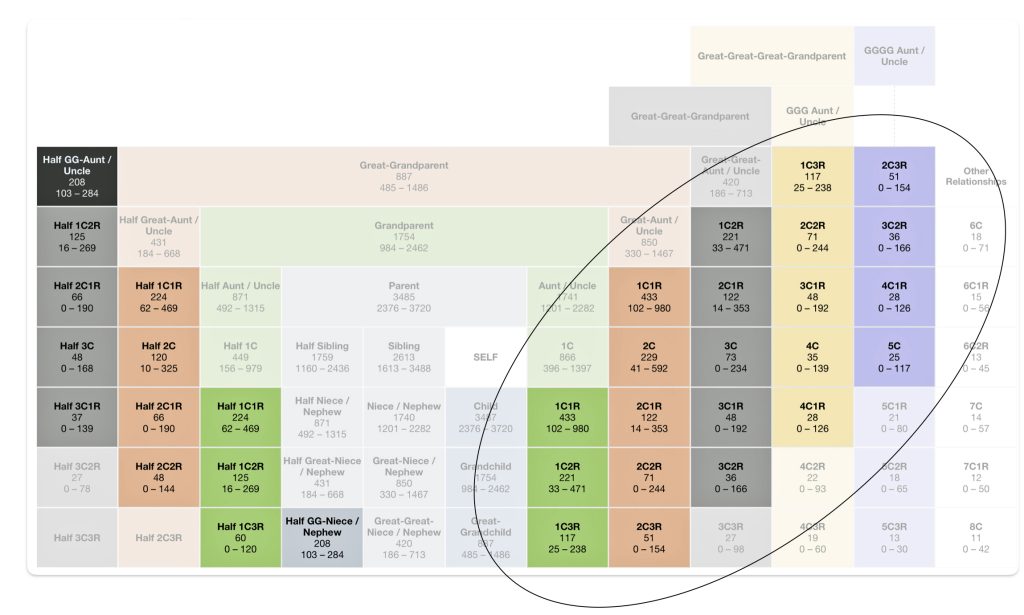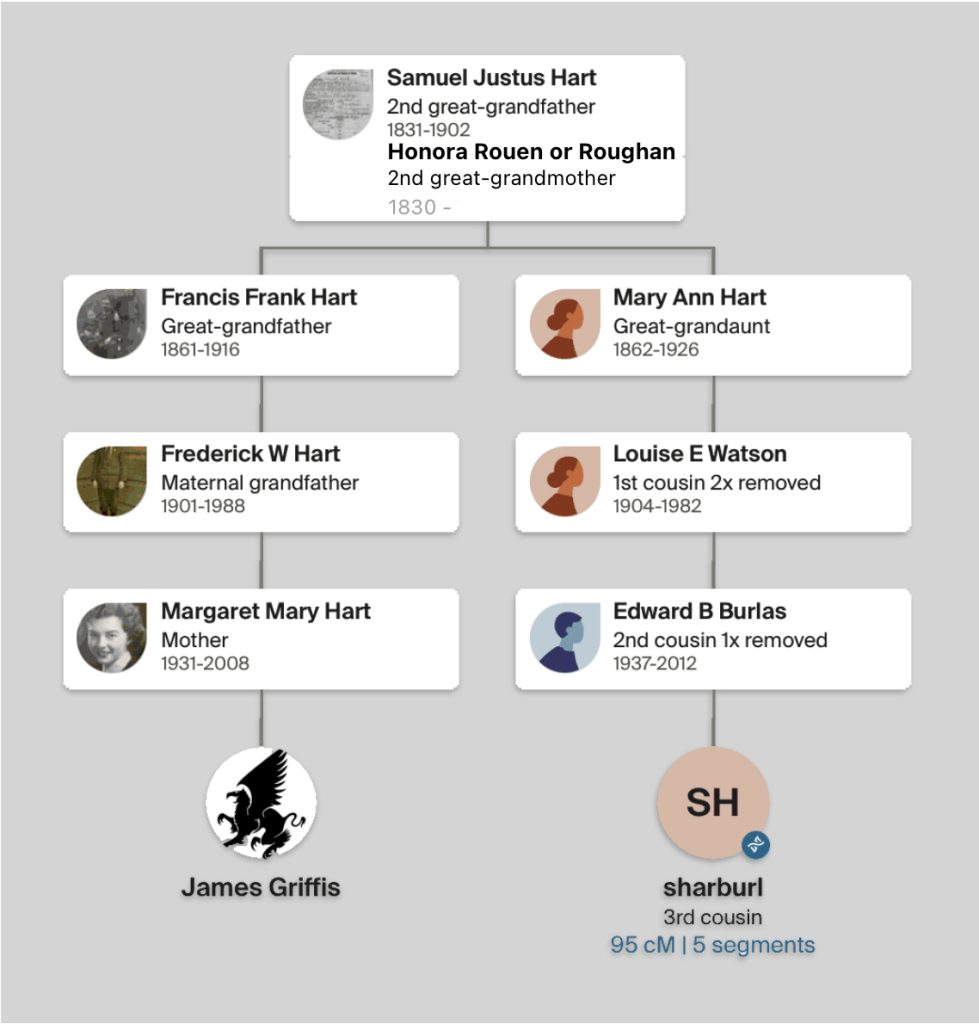This story is a continuation of my discssion on usng autosomal DNA test results to find living distance cousins. The story focuses on five “extended family” autosomal DNA (atDNA) matches from AncestryDNA. These are genetic matches between me and individuals who are living second or third cousins.
The autosomal (atDNA) match results from AncestryDNA indicated five potential matches that are defined as ‘extended family‘. All five genetic matches are cousins on my maternal side of the family. Three of the extended family matches were documented by information provided by the DNA testers through their family tree information. The traditional genealogical information helped with locating our common ancestors and substantiating the family relationship. I was able to document the common ancestors for the other two matches through documentation in my family tree. As stated, all of these matches are newly discovered living relatives on my mother’s side of the family.
My ‘Extended Family’: AncestryDNA Matches on My Mother’s Maternal Side
Photograph of Margaret, Pierce and Theresa Hart

My mother was estranged from her mother, Theresa Schuh, before she was 10. Her older brother of three years, Pierce, was severely intellectually disabled. [1] When Theresa left the family, my grandfather was unable to take care of Pierce. Pierce was institutionalized for the remainder of his life. [2] My mother was shuttled between various ‘foster’ homes and finally stayed with my grandfather’s sister, Mae Whalen. My mother provided little information about her mother or the Schuh side of the family when I was growing up.
Information about my mother’s paternal side of the family was also limited. My grandfather, Frederick Hart, worked in a Ford assembly line plant in Troy, New York for much of his career. He along with his parents, five older brothers and a sister spent most of their lives in the Troy, New York area. [3]
I was, however, fortunate to grow up with and know my grandfather Hart, his sister and three of his five brothers. I have wonderful memories of them, suitable for future stories. However, little was said about the generations before them.
I have been able to piece together much of the history of the Hart family after the passing of Fred Hart’s generation. My mother’s story and stories of his family will be found in future family stories.
Subsequent to my mother’s death, I have learned a bit more about my maternal grandmother’s family. However, I still have many gaps in knowledge on that side of the family. [4]
Having atDNA matches that are from my maternal grandmother’s side of the family is noteworthy. Finding out about my maternal grandmother’s family is akin to what perhaps those who are adopted experience when discovering information about their biological family.
Illustration one lists the five ‘extended family’ matches in AncestryDNA. All matches are above my initial 90 cM filtering threshold for reviewing autosomal matches.
Illustration One: Extended Family AncestryDNA Match Results

Three of the five matches can be traced from my mother’s maternal side of the family. The other two matches have common ancestors from my mother’s paternal side of the family.
The common ancestors for all the matches on my mother’s paternal side of the family are Samuel and Honora (Hannah) Hart. They had two children, Francis Hart and Mary Ann Hart. Francis or Frank Hart was my great grandfather. Mary Ann Hart, Frank’s sister or my great grand-aunt, was married twice and has family descendants from each of the marriages. (See illustration two.)
Two of the five matches are traced through my mother’s paternal side of the family. One of the five matches can be traced through the Nash side of Mary Ann Hart’s descendants and another match can be traced through the Watson side of her descendants.
Illustration Two: Common Ancestors on the Paternal Side of Mother’s Family

The other three matches can be traced through my mother’s maternal side of the family: the Schuh family. The common atDNA ancestors are George and Dorothy Schuh and the common denominator for the atDNA matches are the two siblings Elizabeth and Teresa Schuh.
Illustration Three: Common Ancestors on the Maternal Side of Mother’s Family

(1) Kaja: 179 shared cMs – Second Cousin Once Removed
An individual named Kaja was listed as an extended family match with unweighted shared DNA of 179 cM across 10 segments. The longest cM segment we share is 31 cMs. [5]
If I were to compare this result with the results in the Shared cM Project database, the furthest back I might need to go to find common ancestors for a match of 179 cM is my 4th-Great-Grandparent level or the seventh generation on my pedigree chart. (See illustration four.)
Illustration Four: Estimated Relationships for cM Matches of 179 cM

The results from AncestryDNA indicated that Kaja provided limited information on her family tree. She only had listed her grandparents, Willam and Elizabeth Mittlested, on her mother’s side. I had the Mittlested’s documented in my mother’s family tree.
AncestryDNA deduced that we share common ancestors based on information found in each of our respective family trees. Combining our ‘Ancestry Public Member’s family tree’ information, it was confirmed that our common ancestors are my maternal great-grandparents and her maternal great great-grandparents: George Schuh (1867 – 1929) and Dorothy (Dora) Schutz (1869-1840). Illustration five depicts our family relationship . Kaja’s mother is my second cousin. I have not listed Kaja’s mother name since she is living. (See illustration five).
Illustration Five: Common Ancestors Between Second Cousins Once Removed – Maternal Grandmother’s Line

(2) William: 141 Shared cMs – Second Cousin
As indicated in illustration one above, AncestryDNA pegged William as an half second cousin. William did not provide much in terms of a family tree or other information about his family surnames. His publicly linked AncestryDNA family tree lists three private individuals. Obviously this does not help with researching our possible common ancestors.
In order to determine what our relationship is, based on the cM value of the DNA test, I needed traditional genealogical evidence to narrow the possible genealogical relationships that I may share with William. What gave me an initial clue to determine our common ancestor was his AncestryDNA ‘handle” or name he used for his AncestryDNA account. His AncestryDNA account name was his first name and last name!
Knowing William’s last name gave me a sufficient lead to find additional information to corroborate genetic clues with traditional genealogical sources of fact and evidence. A direct line of genetic descent through my maternal side started with our mutual great grandparents: George and Dorothy Schuh. (See illustration six.) His grandmother Elizabeth Schuh was my maternal grandmother’s sister, Theresa Schuh. His mother Elizabeth Mittelsted, my mother’s first cousin, married Felix Durivage Jr.. I do not know if Elizabeth Mittelsted and Felix Durivarge had more than one child but I am fairly confident that William Durivage is their son.
Illustration Six: My Connection with William (141 Shared cMs)

(3) David: 122 Shared cMs – Second Cousin
The third promising ‘extended family’ match was associated with “David D”. We share 122 cMs across 8 segments. The longest shared segment is 22 cMs.
Similar to William, David did not provide much in terms of a family tree. His publicly linked AncestryDNA family tree lists three private individuals, one of which is probably himself and the two other family members are probably his wife and child. Similar to the challenges faced with the ability to confirm William’s relationship, the lack of information provided by David did not help in isolating a common ancestor.
Applying 122 cMs in the Shared cM Project tool indicates that the furthest back I might need to go to find common ancestors for a genetic match with David is the 4th-Great-Grandparent level or generation seventh generation on my pedigree chart. (See illustration seven.).
Illustration Seven: Possible relationships with a 122 cM Match

As reflected in illustration seven, based on 122 cMs, David conceivably could be one of many relationships to me. Depending on who our common ancestors are, we could be one of the following relations, based on relationship probabilities. [6] The probability that David is any of these relations to me is presented in table one. Based on estimated probabilities of our relationship found in table one, I initially believed there was a 29 percent chance that he was a third cousin or a 12 percent chance he was a second cousin.
Table One: Relationship Probabilities Based on 122 Shared cM
| Probability of Relationship | Possible Relationship |
|---|---|
| 42 % | Half 2C, 2C1R, Half 1C2R, 1C3R |
| 29 % | Half 1C3R, 3C, Half 2C1R, 2C2R |
| 12% | Half 3C 3C1R Half 2C2R 2C3R |
| 12% | Half GG-Aunt/Uncle , 2C, Half 1C1R 1C2R, Half GG-Niece/Nephew |
In order to determine what our relationship is based on the cM value of the DNA test, I needed traditional genealogical evidence to narrow the possible genealogical relationships to one that I may possibly share with David. Similar to William, what gave me an initial clue to determine our common ancestor was his AncestryDNA ‘handle” he used for his AncestryDNA account. His AncestryDNA account name was, like his first cousin, his first name and last name! Knowing David’s last name gave me enough information to find information to corroborate genetic clues with traditional genealogical sources of fact and evidence.
A review of my current information and facts associated with the maternal side of my mother’s family led me to an obituary for Marie (Mittlested) Decker. Marie was one of my mother’s first cousins. Marie Decker’s obituary provided information on her children, her grandchildren and her siblings. David is one of Marie’s four children. [5]
David D is my second cousin, as depicted in illustration eight. Our common ancestors are our great-grand parents.
Illustration Eight: Second Cousins

The connections between me and my two maternal second cousins and my second cousin once removed can be viewed in the following family tree in illustration nine.
Illustration Nine: The Mittelsted Family Connection in Autosomal DNA Testing

(4) James: 113 Shared cMs – Third Cousin on the Mother’s ‘Paternal side’
The fourth promising ‘extended family’ match was associated with “James E”. We share 113 cMs across 7 segments. The unweighted shared DNA is 113 cM and longest segment is 29 cM. AncestryDNA infers that James is possibly my 3rd cousin.
James’ Family Tree

James’ information on his AncestryDNA public family tree is limited. It only goes back to his grandparents. However, based on the names of his grandparents, I was able to trace his ancestral line back to our common ancestor. I had developed an extensive family tree that established a connection with his maternal grandfather’s family line with my mother’s paternal side of the family tree.
His line of descent goes through the Nash side of Mary Ann Hart’s lineage.
According to the information found in AncestryDNA member trees, James and I have two common ancestors that make us third cousins. We share great great-grandparents: Samuel Justus Hart and Honora Rouen. (See illustration ten.)
Illustration Ten: Discovered Third Cousin – Maternal Grandfather’s Line

(5) ‘Sharburl’ : 95 Shared cMs – Third Cousin
‘Sharburl’ and I share 113 cMs across 7 segments of DNA. Our unweighted shared DNA is also 113 cM and the longest segment is 29 cM. As reflected in illustration ten,
Similar to James, the fifth listed atDNA ‘extended family match is also a third cousin that is traced through our common great great-grandparents Samuel and Honora Hart. However, our line of descent goes through Marry Ann Hart’s Watson family line.
Illustration Ten: Discovered Third Cousin – Maternal Grandfather’s Line

Conclusion
For my personal experience, the use of atDNA tests have provided a promising and fruitful approach to identify information and facts for relatives that are both living and deceased. The test results have definitely helped in my efforts to obtain knowledge of a part of my mother’s family.
My initial filtering criteria involved a two step process. The first step involved the use of a cut off value for cMs shared at 90. The second criteria was focusing on matches that provided family tree information.
My next phase in researching the atDNA results from AncestryDNA will involve looking at the 760 matches that are between 16 and 89 cMs. That is a lot of matches! In the second phase, I will focus on matches that have family tree information associated with their DNA results and where common ancestors are identified in their family tree information.
Sources
Feature Image: An amalgam of three different images: (1) The network image of individuals is from Woodbury, Paul, “Who Is This?” 6 Steps to Determine Genetic Relationships of Your DNA Matches, April 2019, LegacyTree Genealogists, https://www.legacytree.com/blog/determine-genetic-relationships . (2) The Colorized chart from Johny Perl, Introducting the updated shared cM tool, 27 Mar 2020, DNA Painter Blog, https://dnapainter.com/blog/introducing-the-updated-shared-cm-tool/ and (3) A Diagram depicting the relationship of a third cousin from 23andMe.
[1] There are the four main levels of intellectual disability (ID), categorized by IQ ranges and functional abilities. Contemporary diagnosis of intellectual disability does not rely solely on IQ scores but also considers adaptive functioning across three domains: conceptual, social, and practical life skills. The level of support needed in these areas is now considered as important as IQ in determining the severity of intellectual disability.
In the 1930’s and 1940’s, individuals who could not rely on extensive support from family members were often placed in state institutions. Many families were forced to institutionalize their children due to: financial inability to provide care, lack of community services, and limited educational opportunities.
Marini, Irmo, Noreen Graf, Michael Millington, Chapter 1: The History of Treatment Toward People With Disabilities, Psychosocial Aspects of Disability, 2nd Edition, 2017, https://connect.springerpub.com/content/book/978-0-8261-8063-6
What You Should Know About Intellectual Disability, Healthline, https://www.healthline.com/health/intellectual-disability
A Step-By-Step Guide to Section 32 Applications, A project of the Intellectual Disability Rights Service, http://www.idrs.org.au/s32/_guide/p040_2_2_DiagnosisTerms.php
Committee to Evaluate the Supplemental Security Income Disability Program for Children with Mental Disorders; Board on the Health of Select Populations; Board on Children, Youth, and Families; Institute of Medicine; Division of Behavioral and Social Sciences and Education; The National Academies of Sciences, Engineering, and Medicine; Boat TF, Wu JT, editors. Mental Disorders and Disabilities Among Low-Income Children. Washington (DC): National Academies Press (US); 2015 Oct 28. 9, Clinical Characteristics of Intellectual Disabilities. Available from: https://www.ncbi.nlm.nih.gov/books/NBK332877/
Intellectual disability, Wikipedia, This page was last edited on 11 November 2024, Intellectual_disability
Intellectual Disability, Cleveland Clinic, https://my.clevelandclinic.org/health/diseases/25015-intellectual-disability-id
[2] Rome State School, 1940 United States Federal Census, New York, Oneida County, Rome, Page 13B, Line 67

[3] The Ford plant on Green Island was an assembly plant that primarily manufactured radiators and heater cores for Ford vehicles. The factory was located on the northern end of Green Island near Troy, New York, along the Hudson River.
The plant opened in 1923 and included both a manufacturing facility and a hydroelectric station to power its operations1. While Ford initially considered using the facility to manufacture tractors and other farming implements, by 1923 the plant was producing radiators, ring gears, and springs.

The plant was located on the north end of Green Island, on 154 acres of former Tibbits family property. The main building of the plant was nearly 1,500 feet long, parallel to the Hudson River. Initially the plant employed 1,000 workers, reaching approximately 1,500 by 1973. The factory closed in 1988 and was demolished in 2004. The hydroelectric plant, which was separate from the manufacturing facility, still remains active today under the Green Island Power Authority.
Holloway, Edgar, Painting of the façade of the Ford Plant offices on Green Island, Green Island, NY, 1975, https://nyheritage.contentdm.oclc.org/digital/collection/p16694coll33/id/68/
Ford Motor Company Green Island Branch in Troy, New York, June 29, 1923, The Henry Ford, https://www.thehenryford.org/collections-and-research/digital-collections/artifact/290410/
Henry Ford’s hydroelectric dream on the Hudson, DFW Elite Toy Museum, https://dfwelitetoymuseum.com/henry-fords-hydroelectric-dream-on-the-hudson/
Green Island, New York, Wikipedia, This page was last edited on 4 May 2024, https://en.wikipedia.org/wiki/Green_Island,_New_York
Johnson, Carl, Mr. Ford Builds His Dream Hydro Plant, 15 May 2018, Hoxie, https://hoxsie.org/2018/05/15/mr-ford-builds-his-dream-hydro-plant/
History, Village of Green Island, https://villageofgreenisland.com/history/
Crowe, Kenneth, Green Island Looks for Development Project, Times Union, 14 Apr 2021, https://www.timesunion.com/business/article/Green-Island-looks-for-development-project-16101527.php
[4] In the course of conducting genealogical research on the Hart family in the last six years, I met a third cousin, Janes Scribner McCrary. Our common ancestor is Samuel and Honera Hart. We have shared facts and evidence on Samuel and Honora Hart. Jane has also assisted my efforts to get a cleared picture of Francis Hart. She had compiled and impressive blog of stories of her family at https://selectedstoriesofmyancestors.blogspot.com
See Jane’s informative stories on the Hart family at:
Scribner McCrary, Jane, Samuel Justus Hart or Justus Samuel Hart?, 15 Sep 2023, Selected Stories of My Ancestors, https://selectedstoriesofmyancestors.blogspot.com/2023/09/samuel-justus-hart-or-justus-samuel-hart.html
Scribner McCrary,Jane, Lost Line from Canada, 18 Jul 2020, Selected Stories of My Ancestors, https://selectedstoriesofmyancestors.blogspot.com/2020/07/lost-line-from-canada.html
Scribner McCrary, Jane, Honora Rouen Hart, 15 Jun 2023, Selected Stories of My Ancestors, https://selectedstoriesofmyancestors.blogspot.com/2023/06/honora-rouen-hart.html
Scribner McCrary, Jane, My Granny – Nina Nash Hughes, 28 Jun 2021, https://selectedstoriesofmyancestors.blogspot.com/2021/06/my-granny-nina-nash-hughes.html
[5] The unweighted DNA value represents the raw amount of shared genetic material measured in centimorgans (cM) before any algorithmic adjustments by AncestryDNA.
Timber is AncestryDNA’s proprietary algorithm designed to filter DNA matches for more accurate genealogical connections. Timber analyzes DNA segments across AncestryDNA’s entire database to identify and filter out segments that are likely shared due to distant population-level ancestry rather than recent common ancestors. It essentially “chops down” DNA segments that don’t help identify recent family connections.
See:
What is Unweighted Shared DNA on Ancestry?, Who are you made of?, https://whoareyoumadeof.com/blog/what-is-unweighted-shared-dna-on-ancestry/
Southard, Diahan, AncestryDNA, Longest Shared Segment and Timber, Your DNA Guide, https://www.yourdnaguide.com/ydgblog/ancestrydna-timber-longest-shared-segment-dna
AncestryDNA Matching White Paper, 15 Jul 2020, AncestryDNA, https://www.ancestrycdn.com/support/us/2020/08/matchingwhitepaper.pdf
[6] Larkin, Leah, The Limits of Predicting Relationships Using DNA, 19 Dec 2016, The DNA Geek, https://thednageek.com/the-limits-of-predicting-relationships-using-dna/
Bettinger, Blaine T., The Shared cM Project 4.0 tool v4, Mar 2020, DNA Painter, https://dnapainter.com/tools/sharedcmv4
[7] Obituary of Marie P. Mittelsted Decker:



